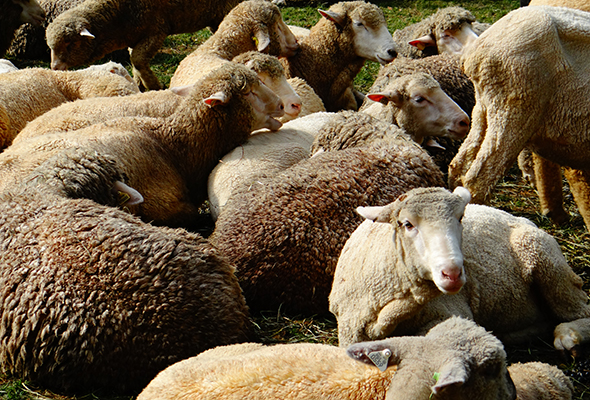
Amidst the hustle and bustle of midtown Manhattan on a sunny autumn day, a surreal sight in Bryant Park surprised even the most cynical New Yorkers. A herd of 30 woolly, white sheep calmly grazed on the park’s green lawn, drawing in crowds throughout the day.
“When I first saw the sheep I thought they were statues. It’s unreal to have live animals in an urban environment,” said Nuno Ferreira, who is visiting New York from Portugal.
The Campaign for Wool, a United Kingdom-based cross-industry initiative for wool, organized the event and brought sheep into Bryant Park as part of its “Wool Uncovered” campaign, which promotes the wool industry and touts the benefits of wool as a durable, breathable, biodegradable, fire-resistant fiber. The campaign also strives to make people aware of how wool is produced and manufactured.
The Prince of Wales convened the Campaign for Wool in the U.K. in 2010 to educate consumers about the natural benefits of the fabric and to help farmers and the wool industry, as prices had fallen for three years. The stateside launch in Bryant Park is the result of six months of planning, and organizers hope to expand the campaign to other U.S. cities.
For the event, the park’s fountain was drained and filled with wool and yarn in blue, yellow and pink. Children played on a richly-colored carpet and people chatted on couches upholstered in union jack and stripe designs. All 3,000 chairs in the park were covered with wool. But the centerpiece attraction was the sheep, held in a 40-foot-by-40-foot compartment made out of plexiglass. Throughout the day, the sheep stayed calm and quiet and munched on hay. Occasionally, you could hear a sheep bleating.
The sheep were brought in at 5 a.m. on a big trailer from the sheep farm Traver Midnight Merinos in Clinton Corners, New York. “I brought in my sheep to hand out business cards here and to hopefully get new customers,” said sheep farmer Jeff Traver, who has been a farmer since 1970. “The fascination of live animals attracts people here and it’s a great way to make customers aware of what wool has to offer.”
A main concern of the organizers was the rain, because a downpour at 7 a.m. began to shrink the wool in the fountain. But two hours later, the sky cleared up and it was a sunny, warm day.
PETA, People for the Ethical Treatment of Animals, demonstrated at noon in front of Bryant Park, to raise awareness of how they say sheep are mistreated and abused in the wool industry. A PETA member dressed up in a bloody sheep costume.
“The sheep on display are suffering,” said PETA campaign specialist Ashley Byrne. “It’s inappropriate to bring them into noisy and crowded midtown Manhattan. When the sheep’s wool production declines, they’re being slaughtered. But the wool industry would never want consumers to see that it’s a bloody industry.”
“It’s a phony event,” she added.
A table showcased how raw wool is sorted and the benefits of the product. Wool is a sustainable, renewable, natural and fire-resistant fiber. Its production is environment-friendly, involving low carbon emissions.
Wool is produced in all 50 states in America, though East Coast wool farmers produce smaller volumes. American wool has various uses – mainly in carpeting, home furnishing and the clothing industry. In New York City, the price for wool per pound in 2011 was 60 cents, according to the U.S. Department of Agriculture, up from 40 cents in 2010.
“The wool industry has been getting better over the last year and demand and supply has stabilized,” said Rita Kourlis Samuelson, who is the wool marketing director for the American Wool Council. “Wool has been around since the Stone Age, and people are turning towards the fiber again, after a long low period for the industry.”
The high foot traffic in Bryant Park is what makes it a great location to attract a lot of people. “Of course we have to take into consideration that the event is taking away space from the public,” said Ethan Lercher, who is the event coordinator for Bryant Park Corporation. “As long as people can take away ideas from an event and learn something, it’s worth it.”
“I’m not sure if the event pays off considering the cost of it, but it’s definitely surprising and gets people talking,” said Marton Hajdu, who came to New York from Brussels for five days on a business trip.